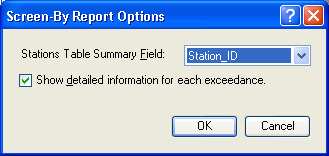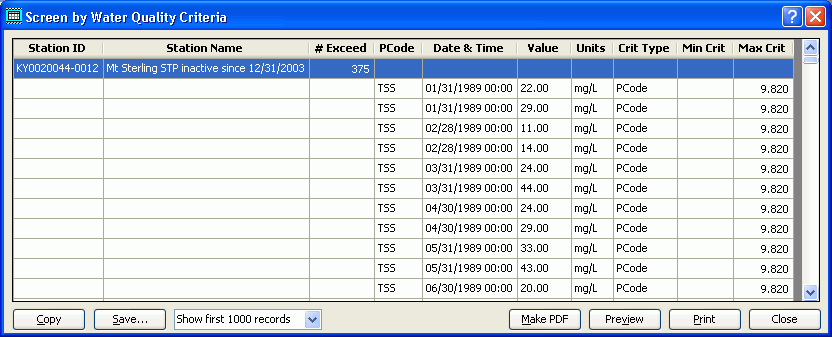These reports display only those records that are outside of pre-defined limits specified in the PCODES Support table. Screen by Lab Test Limits compares observations to the MINLIMIT and MAXLIMIT fields whereas Screen by Water Quality Criteria compares to the MINCRITERIA and MAXCRITERIA fields (as well as other override fields found in the Criteria table, as explained in a moment).
You are first prompted thus:

The summary field selection is used to identify which field in the Stations Support table will be used to create summaries and subtotals. You can also choose whether to display all individual exceedances or just summary information.
Having global criteria limits by PCode is sometimes inadequate to characterize criteria compliance in a real project. For example, criteria values may vary by location or month. To enhance your ability to identify exceedances, the Criteria Support table is available so you can specify overrides. In this table, enter a unique name, the PCode, an optional comma separated list of applicable month numbers, and a value for one (and only one) of the Stations fields (e.g., Station ID, Station Type, River Basin, etc.). Finally, enter minimum and maximum criteria limits (empty cells mean there is no limit). When the Criteria Limits report is generated, violations will be first based on limits found in the PCodes table and then upon the overrides in this table. Care must be taken when selecting different Stations fields, because a Station ID theoretically could match more than one entry in the override table. In this case overrides will be adopted based on the numeric value found in the Priority column (a larger number causes that row's rule to take precedence over other rules). See Support Table Browsers for more information.
A typical Criteria Limits report looks like this:

Note that the "Crit Type" column identifies which criteria option was used for that particular exceedance item (e.g., were the criteria taken from the PCodes table or from one of the Stations fields in the Criteria table).